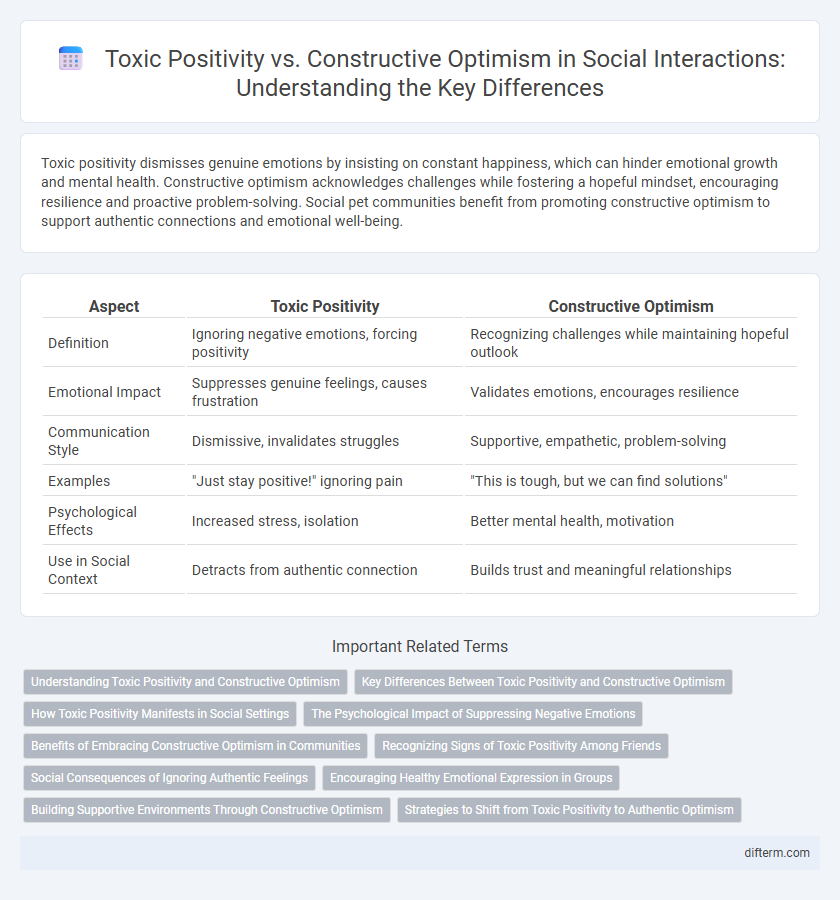Toxic positivity dismisses genuine emotions by insisting on constant happiness, which can hinder emotional growth and mental health. Constructive optimism acknowledges challenges while fostering a hopeful mindset, encouraging resilience and proactive problem-solving. Social pet communities benefit from promoting constructive optimism to support authentic connections and emotional well-being.
Table of Comparison
| Aspect | Toxic Positivity | Constructive Optimism |
|---|---|---|
| Definition | Ignoring negative emotions, forcing positivity | Recognizing challenges while maintaining hopeful outlook |
| Emotional Impact | Suppresses genuine feelings, causes frustration | Validates emotions, encourages resilience |
| Communication Style | Dismissive, invalidates struggles | Supportive, empathetic, problem-solving |
| Examples | "Just stay positive!" ignoring pain | "This is tough, but we can find solutions" |
| Psychological Effects | Increased stress, isolation | Better mental health, motivation |
| Use in Social Context | Detracts from authentic connection | Builds trust and meaningful relationships |
Understanding Toxic Positivity and Constructive Optimism
Toxic positivity dismisses genuine emotions by insisting on excessive positivity, which can hinder emotional well-being and authentic connections. Constructive optimism encourages realistic hope and resilience, acknowledging challenges while focusing on actionable solutions and growth. Recognizing the difference helps build healthier social interactions and supports mental health by validating feelings without fostering negativity.
Key Differences Between Toxic Positivity and Constructive Optimism
Toxic positivity dismisses genuine emotions by encouraging an unrealistic, always-positive mindset that invalidates struggles and promotes suppression of negative feelings. Constructive optimism acknowledges challenges while fostering hope and resilience through realistic expectations and problem-solving strategies. The key difference lies in toxic positivity's denial of hardship versus constructive optimism's balanced approach to adversity and emotional authenticity.
How Toxic Positivity Manifests in Social Settings
Toxic positivity manifests in social settings through dismissive responses that invalidate genuine emotions, such as telling someone to "just stay positive" during struggles. This behavior often suppresses authentic dialogue, preventing individuals from seeking support or expressing vulnerability. Constructive optimism, in contrast, encourages realistic hope while acknowledging challenges, fostering empathetic and supportive interactions.
The Psychological Impact of Suppressing Negative Emotions
Toxic positivity, characterized by the dismissal of negative emotions, can lead to increased psychological distress and emotional suppression, negatively impacting mental health. Constructive optimism encourages acknowledging and validating difficult feelings while fostering hope and resilience, promoting emotional well-being. Suppressing negative emotions often results in heightened stress, anxiety, and decreased authentic self-expression, hindering long-term psychological growth.
Benefits of Embracing Constructive Optimism in Communities
Embracing constructive optimism in communities fosters resilience by encouraging realistic hope and proactive problem-solving, which enhances emotional well-being and collective growth. Unlike toxic positivity, which dismisses valid emotions, constructive optimism validates challenges while focusing on achievable solutions, strengthening social bonds and trust. This balanced approach promotes a supportive environment where members feel empowered to address difficulties and contribute positively.
Recognizing Signs of Toxic Positivity Among Friends
Recognizing signs of toxic positivity among friends involves identifying dismissive responses to genuine emotions, such as insisting on constant happiness or invalidating feelings of frustration and sadness. Friends who downplay struggles with phrases like "just stay positive" or "it could be worse" often hinder emotional growth and authentic connection. Constructive optimism, in contrast, encourages acknowledging difficulties while promoting hopeful, realistic solutions without negating emotional experiences.
Social Consequences of Ignoring Authentic Feelings
Ignoring authentic feelings through toxic positivity can lead to social isolation, as individuals may feel misunderstood or dismissed by peers who expect constant happiness. Constructive optimism fosters genuine support by encouraging realistic hope and emotional validation, strengthening social bonds and trust. Neglecting true emotions risks eroding communication quality, causing resentment and weakening interpersonal relationships.
Encouraging Healthy Emotional Expression in Groups
Encouraging healthy emotional expression in groups involves recognizing the difference between toxic positivity and constructive optimism. Toxic positivity dismisses genuine feelings by insisting on a relentlessly cheerful outlook, which can inhibit authentic communication and emotional support. Constructive optimism fosters resilience by validating emotions while promoting positive, realistic perspectives that strengthen group cohesion and mental well-being.
Building Supportive Environments Through Constructive Optimism
Constructive optimism fosters supportive environments by encouraging realistic hope and acknowledging challenges while promoting growth and resilience. Unlike toxic positivity, which dismisses genuine emotions and invalidates struggles, constructive optimism validates feelings and motivates problem-solving and collaborative support. This balanced approach enhances mental well-being and cultivates trust within social groups, enabling stronger, more empathetic connections.
Strategies to Shift from Toxic Positivity to Authentic Optimism
Shifting from toxic positivity to authentic optimism involves embracing vulnerability by acknowledging genuine emotions and validating personal experiences without dismissing pain. Practicing self-compassion and encouraging open, empathetic conversations fosters an environment where challenges are recognized as opportunities for growth rather than ignored or minimized. Incorporating mindfulness techniques and realistic goal-setting supports maintaining a balanced perspective, promoting resilience while avoiding the pitfalls of forced positivity.
toxic positivity vs constructive optimism Infographic

 difterm.com
difterm.com